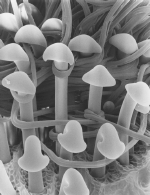Mystery
Monarch Adaptation
How Does it
Help the Creature Survive?
Activity, Part 1: Laying the Groundwork
 |
| Click to enlarge photo |
The inquiry process begins when students experience a phenomenon that raises compelling questions!
- Show students
the image to the right. Without revealing what they are seeing, ask
students:
* How would you describe what you see?
* What does it remind you of?
* What do you suppose it is?
- Next,
reveal that this picture is actually a part of a young monarch magnified
180 times. It is an example of a physical adaptation: a part
of its body that helps it survive in its habitat.
Share this hint: A monarch has this body part only during the two weeks the young monarch needs it. Pose these challenge questions:
* What part of a monarch do you think this is?
* What do you think it does or helps the monarch do?
* What clues did you get from your observations?
* How might it help the monarch survive?
- Ask a question about objects, organisms, or events. (K-4)
- Each plant or animal has different structures that serve different functions in growth, survival, reproduction. (K-4)
- Living systems at all levels of organization demonstrate the complementary nature of structure and function. (5-8)
- Biological adaptations include changes in structures, behaviors, or physiology that enhance survival and reproductive success in a particular environment. (5-8)


